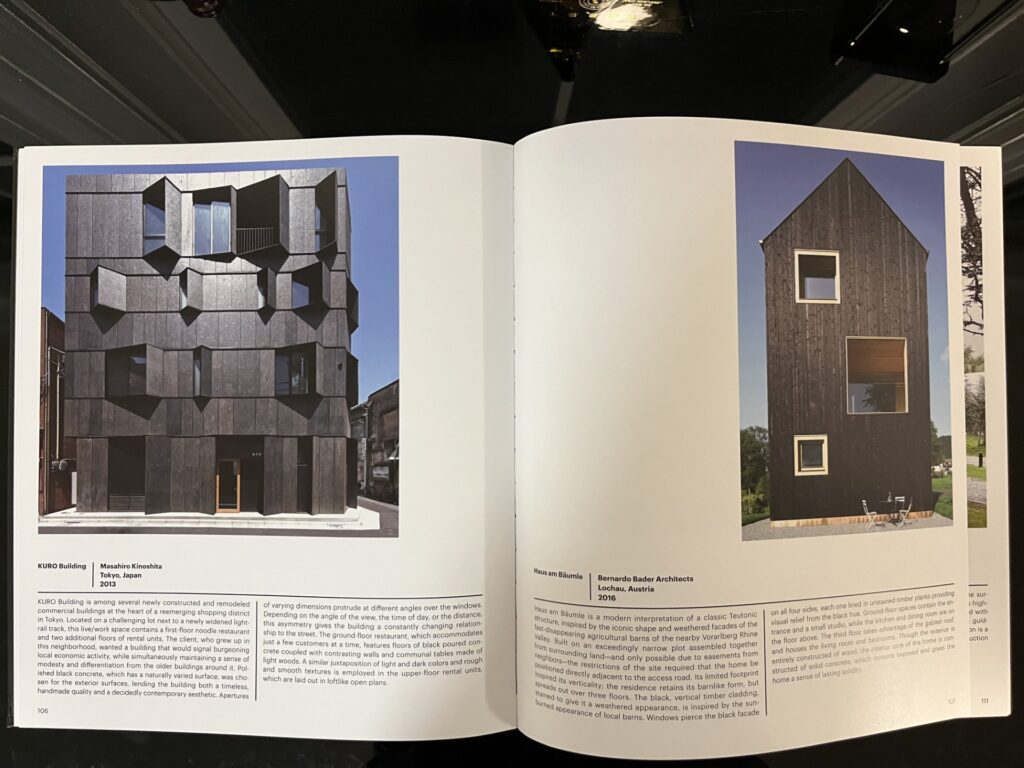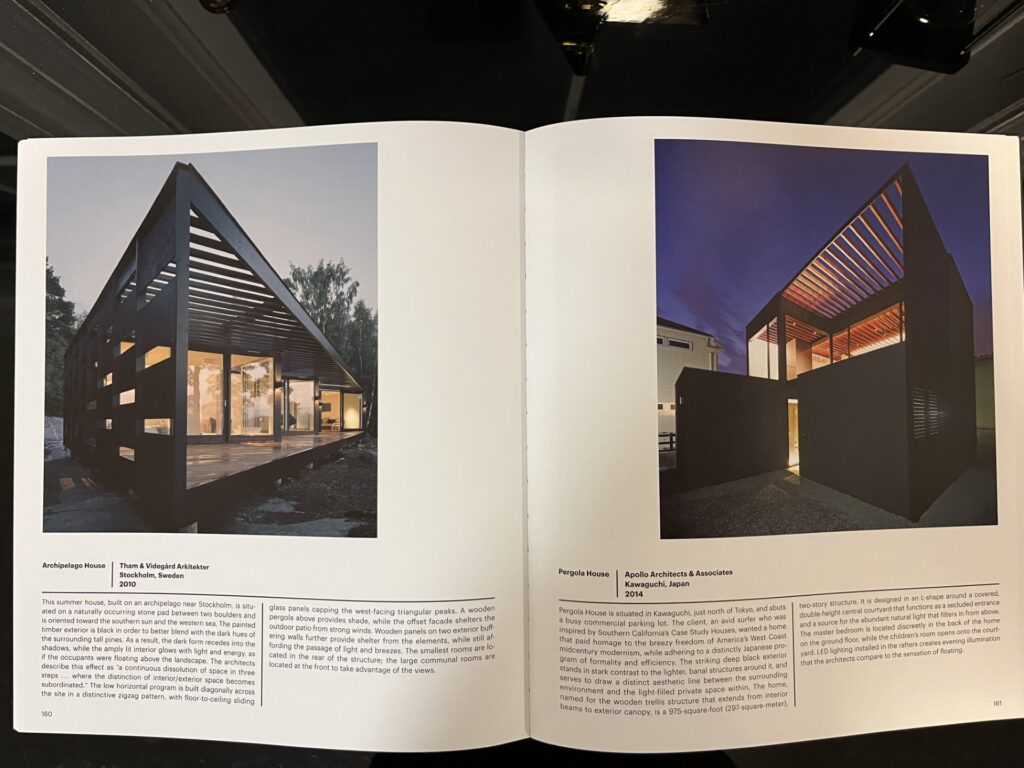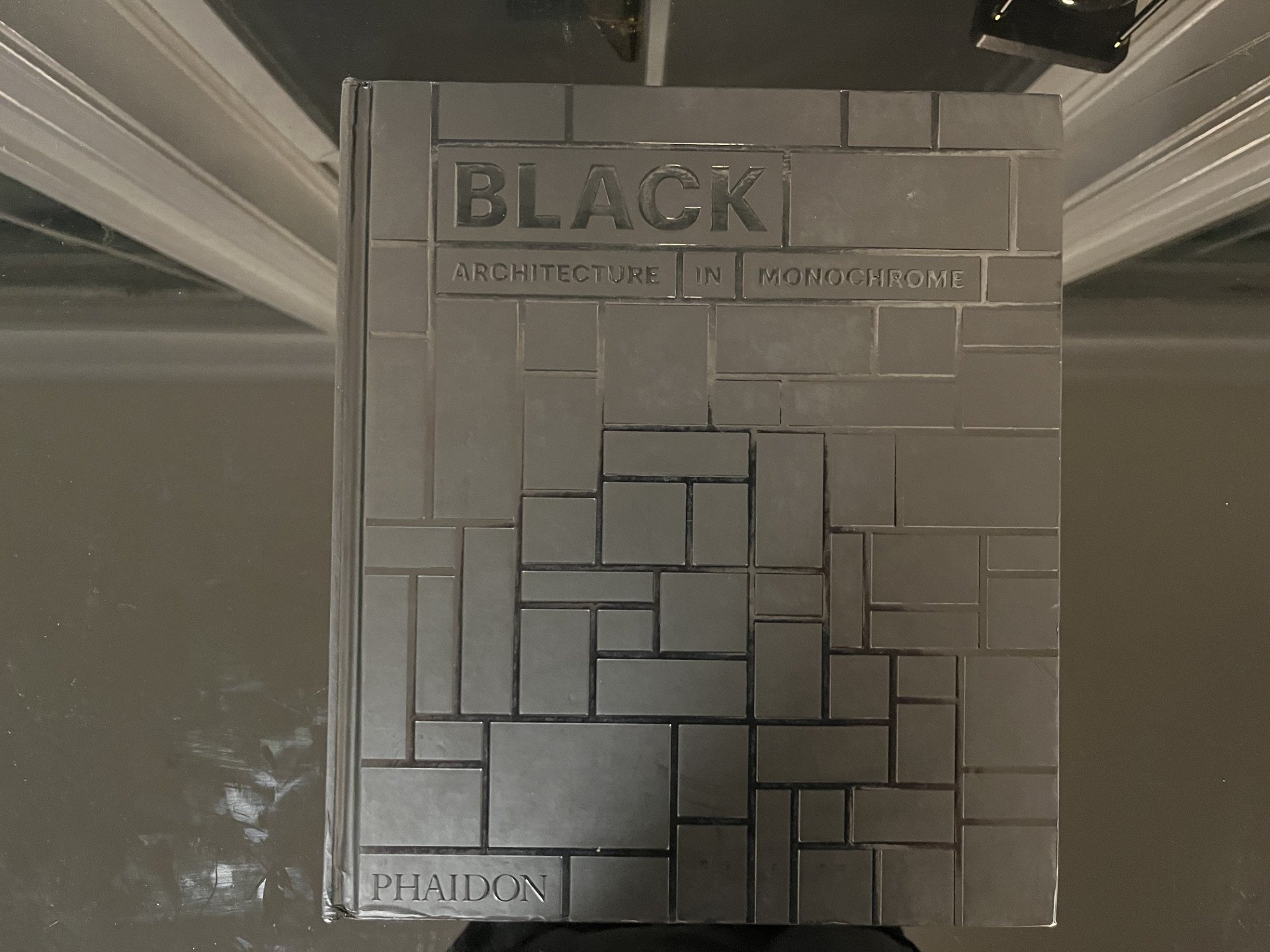“Black: Architecture in Monochrome” is an eye-catching coffee table book that showcases the beauty of black structures throughout history. With over 150 stunning buildings featured, it reveals how dark architecture can evoke strong emotions and make a striking statement in design. This book captures the elegance of black in a way that appeals to both architecture enthusiasts and casual readers alike.
As readers flip through its pages, they encounter a mix of history, artistry, and design philosophy that highlights the significance of these structures. Each building tells a story, blending simplicity with complexity, inviting readers to appreciate the depth of monochrome architecture. It serves as both an art piece and a source of inspiration for those interested in modern and historical design.

This visually rich collection encourages exploration and reflection on how color shapes our world. Whether it’s for a personal library or a conversation starter on a coffee table, this book offers a delightful journey into the realm of black architecture.
The Essence of Black in Architectural Design
Black has a unique power in architecture. It can create a sense of elegance, strength, and drama. Many famous architects have used black to highlight forms and textures in their designs.
In “Black: Architecture in Monochrome,” readers see how black can transform spaces. The book showcases over 150 structures that use black as a key element.
Here are some benefits of incorporating black into architecture:
- Timeless Appeal: Black never goes out of style. It adds a classic touch to modern and traditional designs.
- Visual Impact: Black creates striking contrasts with other colors, making elements stand out.
- Emotional Depth: The color can evoke feelings of sophistication and seriousness.
From ancient churches to contemporary skyscrapers, black has been beloved by architects for centuries. It offers a bold statement while allowing other colors to shine.
In addition, black reflects the surrounding environment beautifully, blending seamlessly with natural elements. This versatility makes it an essential part of architectural design.
The allure of black in architecture is not just visual; it also invites contemplation. This elegant color encourages viewers to appreciate the details in design.
Historical Perspectives on Black Architecture
Black architecture holds rich meaning through various cultures and periods. It illustrates how the color black has shaped design, symbolized power, and influenced aesthetics in buildings worldwide. This section explores the cultural significance of black in different civilizations and traces the evolution of black architecture through time.
Cultural Significance of Black in Various Civilizations
In many cultures, black has symbolized strength, authority, and sophistication. Ancient Egyptians often used black to represent fertility and life, especially in their art and architecture. In contrast, the Mongolian culture sees black as a symbol of the eternal sky, influencing their yurt designs.
European architecture also embraced the color black during the Gothic period, with black stones and slate giving buildings a majestic appearance. Today’s contemporary architects explore black as a minimalist choice, emphasizing its elegance. Thus, black architecture reflects the values and beliefs of its time, making it more than just color—it’s a statement.
Evolution of Black Architecture Over Time
Black architecture has transformed significantly over the centuries. During the Renaissance, architects incorporated dark stone to enhance grandeur. This trend continued, leading to the Industrial Revolution, where factories and warehouses often featured black materials for their functional appeal.
In modern times, designs have shifted towards sustainable and artistic use of black. Innovative architects utilize dark shades in eco-friendly materials, enhancing energy efficiency. A prime example is the Vitra Fire Station in Germany, which uses black to create a striking silhouette against the landscape. This evolution shows how black architecture adapts to contemporary needs while preserving its historical roots.
Architects and Their Iconic Black Creations

This section highlights remarkable architects who have made significant contributions to black architecture. Their iconic works show how black structures can blend beauty and function, making a lasting impact on the landscape.
Pioneers of Monochrome Architecture
Several architects pioneered the use of black in their designs, setting trends for future generations. One notable figure is Mies van der Rohe, whose use of black steel transformed modern architecture. His famous Barcelona Pavilion is a striking example, with open spaces and strong lines that emphasize simplicity.
Another important name is Louis Kahn, known for his monumental brick buildings. The Salk Institute showcases deep, dark materials, creating a contrast with light and space. These pioneers laid the groundwork for understanding how black can enhance architectural design.
Contemporary Black Architecture Masters
In today’s architectural world, several masters continue to push the boundaries of black structures. David Adjaye is a leading figure, known for his innovative designs that celebrate cultural heritage. His National Museum of African American History and Culture in Washington, D.C., uses a dark exterior that draws people in while invoking deep themes.
Zaha Hadid’s work also plays with black materials, seen in projects like the Guangzhou Opera House. Her fluid forms and bold use of color elevate the role of black in contemporary design, making her an influential figure in architecture.
Award-Winning Black Structures

Many iconic black buildings have received prestigious awards. The Heydar Aliyev Center by Zaha Hadid stands out for its unique, flowing design that redefines conventional spaces. This building’s dark outer layer contrasts beautifully with the surroundings.
The Louvre Abu Dhabi, designed by Jean Nouvel, also enjoyed acclaim. Its intricate dome casts beautiful shadows on visitors, creating an enchanting experience. Such structures show how black can be both elegant and functional, winning admiration worldwide.
Materials and Textures in Black Architecture
In black architecture, materials and textures play a crucial role in creating visual impact and emotional resonance. The following points highlight innovative material use, how light interacts with these surfaces, and sustainable choices that enhance black structures.
Innovative Use of Black Materials
Architects often turn to materials like basalt, slate, and charcoal for their deep black tones. These materials provide not only a rich visual appeal but also durability. When used in construction, they can withstand weathering while maintaining their color over time.
Additionally, materials like blackened steel or glass are becoming popular. They reflect modernity and elegance, adding to the aesthetic of a building. This innovative use of various materials helps create stunning designs.
Interaction of Light and Shadow
Black architecture skillfully utilizes light and shadow to enhance its design. The contrast created by dark surfaces allows for dramatic effects. Shadows become more pronounced, giving the building depth and dimension.
In many cases, the surrounding environment affects how light interacts with these structures. For example, a black building in a sunlit area may appear different than one in a shaded setting. This interplay creates an ever-changing appearance that captivates observers.
Sustainability and Eco-Friendly Black Materials
Sustainability is increasingly essential in black architecture. Many architects are choosing eco-friendly materials that reduce environmental impact. Options like recycled metals and sustainably sourced wood provide stunning black finishes without harming the planet.
Some projects incorporate solar panels and green roofs. These features not only enhance energy efficiency but also blend stylishly with black materials. This commitment to sustainability is an important step in modern architectural design, appealing to environmentally conscious buyers.
The Aesthetics of Monochrome
Monochrome design, particularly when using black, evokes strong feelings and creates striking visuals. The use of black in architecture goes beyond mere color choice; it influences psychology and the way spaces feel. The following sections explore its psychological effects and visual impact.
Psychology of Black in Design
Black is powerful in design. It can signify elegance, sophistication, and timelessness. In many cultures, black represents authority and formality, making it a popular choice for luxury brands and high-end architecture.
In residential and commercial spaces, black can create a sense of intimacy. It can also provide a dramatic backdrop that emphasizes other colors, textures, or natural elements. This intentional use often helps to capture attention and drive emotional responses.
When used in moderation, black can enhance comfort and calmness. However, excessive use might evoke feelings of sadness or loneliness. Designers carefully balance this color to create desired atmospheres.
Visual Impact of Black Architectural Elements
Black architectural elements stand out in environments filled with lighter tones. They create a striking contrast that draws the eye and highlights specific features of a structure.
Structures with black facades often appear more modern and sleek. The choice of materials plays a significant role here. Metal, glass, and concrete in black can amplify the feeling of weightlessness or transparency.
Architects like Tadao Ando and Zaha Hadid have used black to create bold statement pieces. Their buildings challenge traditional designs and invite exploration. The visual impact goes beyond aesthetics; it transforms the perception of space.
By thoughtfully incorporating black, architects can craft memorable and engaging experiences in their designs.
The Role of Black in Interior and Exterior Spaces
The color black serves a significant role in both interior and exterior design. It can create a sense of elegance and depth, whether it’s used in small rooms or expansive outdoor areas. Here are two key aspects of how black can be applied effectively in design.
Maximizing Small Spaces Using Black
Using black in small spaces can make them feel more sophisticated. Dark walls or furniture can create an intimate atmosphere that draws people in. To keep a space from feeling too enclosed, layering different shades of black can add depth.
Incorporating black accents like picture frames or light fixtures can also help. These features bring attention to specific areas while adding contrast. Mirrors with black frames can reflect light and expand the perceived size of a room.
Choosing sleek, modern furniture in black can add a stylish touch. Black furniture pieces, like sofas or chairs, can act as anchors in a small room. They allow for more vibrant colors to be added in decor and textiles.
Black in Landscape Architecture
In landscape architecture, black can contribute to a striking aesthetic. Black materials, like stone or metal, bring a contemporary look to gardens or patios. Using black planters or outdoor furniture can create a cohesive design.
Additionally, black can be used to frame natural elements. For example, black paths can highlight beautiful greenery or colorful flowers. This contrast helps to make landscaped areas stand out.
Lighting is another important aspect. Black outdoor fixtures can provide elegant illumination at night. They maintain the design’s sleek theme while enhancing safety and usability.
Challenges and Controversies
Exploring black architecture reveals some challenges and controversies. Many people appreciate the aesthetic of dark buildings, but there are concerns about maintenance and public perception.
Maintenance and Practicality Issues
Black buildings can be striking, but they often require more upkeep than lighter structures. The color absorbs heat, which can increase energy costs for cooling.
Additionally, they show dirt, dust, and smudges more than lighter exteriors. Regular cleaning is essential to maintain their appearance. This adds time and effort to property management.
Homeowners and builders must consider these practical aspects before committing to a dark design. Evaluating the long-term care needed is essential for anyone interested in this architectural trend.
Criticisms and Public Reception
Not everyone is a fan of black architecture. Some critics argue that dark buildings can dominate landscapes, creating a sense of gloom.
Public opinion varies by location. In urban areas, black structures may be viewed as modern and trendy. In suburban settings, they might be seen as out of place.
Community feedback can influence acceptance. Some residents appreciate the design for its boldness, while others prefer lighter, more traditional options. The conversation about black architecture often raises questions about aesthetics and social values.
Photography and Presentation in the Book
The book Black: Architecture in Monochrome features stunning photography that showcases the beauty of black structures. Each image captures the unique characteristics of the buildings, emphasizing their form and design.
The presentation is both elegant and striking. With a clean layout, the photographs stand out, allowing readers to appreciate the details without distraction.
Key features include:
- High-quality images that highlight textures and materials.
- Thoughtful arrangements that guide the viewer’s eye.
- Captivating quotes that add depth to the visual experience.
This book not only serves as a visual feast but also draws connections between architecture, culture, and the artistic process. Each photograph is carefully selected, revealing the essence of what black architecture represents.
Readers will find themselves immersed in the rich history and significance of these structures. The combination of photography and presentation creates an engaging atmosphere, making it an excellent addition to any coffee table or personal library.
Influence on Modern Design and Popular Culture
“Black: Architecture in Monochrome” showcases how dark architectural styles have influenced contemporary design. Many architects now embrace the bold use of black in their works, finding it creates striking contrasts and enhances other colors.
This book highlights over 150 black structures, showing their place in history. From ancient buildings to modern skyscrapers, these designs impact trends in various fields.
Key Influences:
- Minimalism: The use of black supports minimalist design, focusing on simplicity and functionality.
- Urban Aesthetics: Many cities feature black buildings, shaping the skyline and urban environments.
- Fashion and Art: The black palette crosses over into fashion and art, inspiring collections and exhibitions.
The allure of dark architecture captures public imagination. It resonates with the themes of sophistication and elegance, making it a popular choice for designers and artists alike.
As a coffee table book, it appeals to a wide audience, inviting conversations about creativity and cultural shifts. The blend of architecture and artistic expression continues to inspire people everywhere.
Further Reading and Resources
For those interested in exploring black architecture further, there are some great resources available.
Books:
- Black: Architecture in Monochrome by Phaidon Editors offers a stunning journey through dramatic black structures. It combines insightful texts with striking photography.
- Black Architecture in Monochrome (mini format) captures the elegance of black in architecture with over 150 examples. This compact book is visually rich and easy to handle.
Websites:
- The Phaidon site features previews and details about their book collection. It’s a great place to find more design inspiration.
- Goodreads provides user reviews and ratings for Black: Architecture in Monochrome, helping readers choose their next read.
Articles:
- Online reviews, like this one, dive into the themes and insights of the book. They offer critical perspectives that enhance understanding of black architecture.
